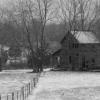I have a subpanel in my garage that is on a 50 amp circuit in the house. I will be running a new line from the garage panel to a building in the back to be a new shop (75 feet from garage panel to shop panel).
One man hobby shop, small space, 11x16. Tablesaw, dust collector and planer all 220v and 3 hp. BS and DP are 110v. Will only run the DC and one tool at a time, along with lights and possibly window unit A/C.
I'm thinking I'd like 60 amps, but my question is, can I replace the 50 amp breaker in the house with a 60 amp, and add a 60 amp breaker to the garage? I can size the new garage-to-shop circuit properly, but I'm worried about the circuit from the house to the garage, it may not be designed for 60 amps.
What do you think?
Thanks!




 Reply With Quote
Reply With Quote


